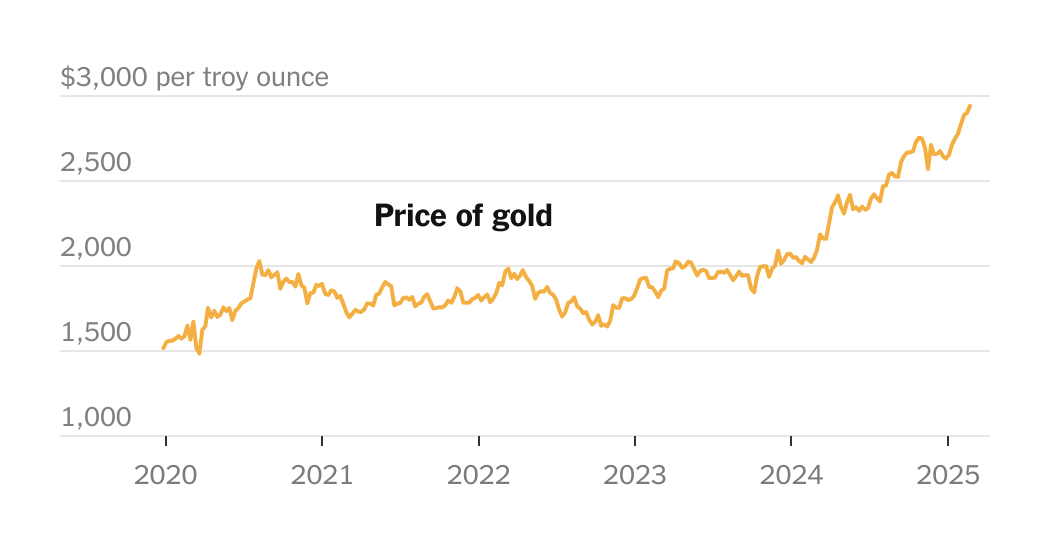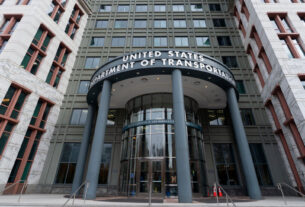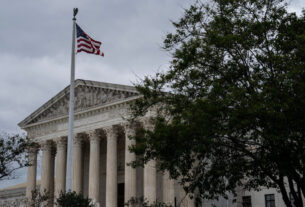At his inauguration, President Trump said that “the golden age of America begins right now.” He was right, in one sense.
The price of gold has been bursting through records in the first month of Mr. Trump’s second term, recently trading at more than $2,900 per troy ounce. It is up about 12 percent already this year, on top of a 27 percent gain last year. Many strategists are upgrading their forecasts, predicting more gains ahead.
There is so much demand for gold in New York, the global hub for futures trading, that it has led to long wait times to get bars out of vaults in London, where the physical market for gold is based.
Gold has risen in the popular consciousness, too: Mr. Trump said on Wednesday that officials in his administration would go to Fort Knox, the military base that houses about half of the Treasury Department’s gold reserves, “to make sure the gold is there.” (Treasury Secretary Scott Bessent later said that it was.)
Gold is traditionally considered a haven asset, sought out by investors during times of turmoil. But, curiously, U.S. stocks have continued to set their own records, and the labor market looks solid.
Instead, among the explanations for the gold rush are fears about Mr. Trump’s policies on tariffs and deportations causing stronger inflation and worsening geopolitical tensions.
“These moves lately have been driven since the election of Donald Trump,” said Giovanni Staunovo, a commodities analyst at the Swiss bank UBS.
“There is a search for assets that are considered uncorrelated to other markets, perceived as an insurance asset,” he added. Gold is “not perfect” for this purpose, he said, but investors’ belief that now is a good time to hold it has supported demand for the precious metal.
Trade war looming? Buy gold.
Mr. Trump has threatened “reciprocal” tariffs on other countries, which could upend the rules of global trade. If a “full-blown” trade war were to break out, gold would be the best performing asset, according to a majority of global fund managers recently surveyed by Bank of America.
The potential impact of tariffs on inflation and economic growth has “played to gold’s strengths,” said Louise Street, a strategist at the World Gold Council, a trade association in London.
There are also fears that tariffs may be applied directly to gold imports, which is leading to stockpiling in the United States. The gold inventory at the New York-based Commodity Exchange, or COMEX, has increased more than 70 percent since the start of the year.
This concern about tariffs is part of the reason UBS recently raised its forecast for the price of gold, saying it will hit $3,000 per ounce at the end of the year.
Trans-Atlantic demand imbalance? Buy gold.
Normally, the price of gold in New York and London is roughly the same, but recently this gap has widened: The New York price is substantially higher, driven in part by demand linked to fears of potential tariffs. Traders looking to take advantage of that price differential have been moving gold to New York from London.
Gold is heavy and needs lots of security. It is cumbersome and costly to move, unlike currencies, stocks, bonds or many other financial assets that zap digitally across borders.
That has led to long wait times for moving gold out of British vaults, like at the Bank of England, which has more than 400,000 gold bars, one of the largest stocks in the world.
Dave Ramsden, a deputy governor at the central bank, said recently he was delayed getting to work because of a truck parked in the bullion yard at the bank. But he downplayed worries about gold pouring out of London, saying the overall stock at the bank had only declined about 2 percent since the end of last year.
Another quirk in the gold market adding to bottlenecks is that the New York warehouses used by gold traders accept only gold bars of a certain size and weight. That means the gold shipments from London go first to Switzerland, home of the world’s largest gold refineries, to be melted down and reformed into a smaller shape and then sent on to New York. Swiss gold exports to the United States shot up to more than 190 metric tons in January, triple the amount in December.
This slow, unwieldy process is also a factor pushing up the value of gold, albeit a temporary one. “It’s not a shortage; it’s purely a bottleneck,” said Ms. Street of the World Gold Council.
Shifting away from the dollar? Buy gold.
Even though the recent gains for gold have been heady, the price has been climbing for the past few years. That has been driven by a huge increase in gold buying by central banks. Since 2022, central banks have bought more than 1,000 metric tons of gold each year, an “eye-watering pace,” according to the World Gold Council.
This buying is expected to continue, putting upward pressure on the gold price. Goldman Sachs recently upgraded its forecast, to $3,100 per ounce this year, citing central bank demand. For some central banks, the purchases are a way to diversify their reserves, reducing their reliance on dollars, U.S. Treasuries and other foreign-currency assets.
Poland’s central bank has been one of the biggest buyers in recent years, with plans to increase gold to 20 percent of its reserves. Other big buyers have been the central banks of China, India and Turkey.
In Poland, the gold purchases “have not only increased the prestige of the Polish central bank, but also improved the financial security of Poland, which is particularly important in the face of the current tense geopolitical situation,” said Adam Glapinski, the governor of the country’s central bank.
After Russia invaded Ukraine in early 2022, the Russian central bank’s foreign reserves, which included dollar- and euro-denominated assets, were frozen, an unprecedented financial sanction that weaponized international financial systems.
“That triggered some fears among central banks or governments” that they “could be the next one,” said Mr. Staunovo of UBS. That’s one reason, he added, central banks have been “the dominant factor for pushing the gold price towards a record high.”





